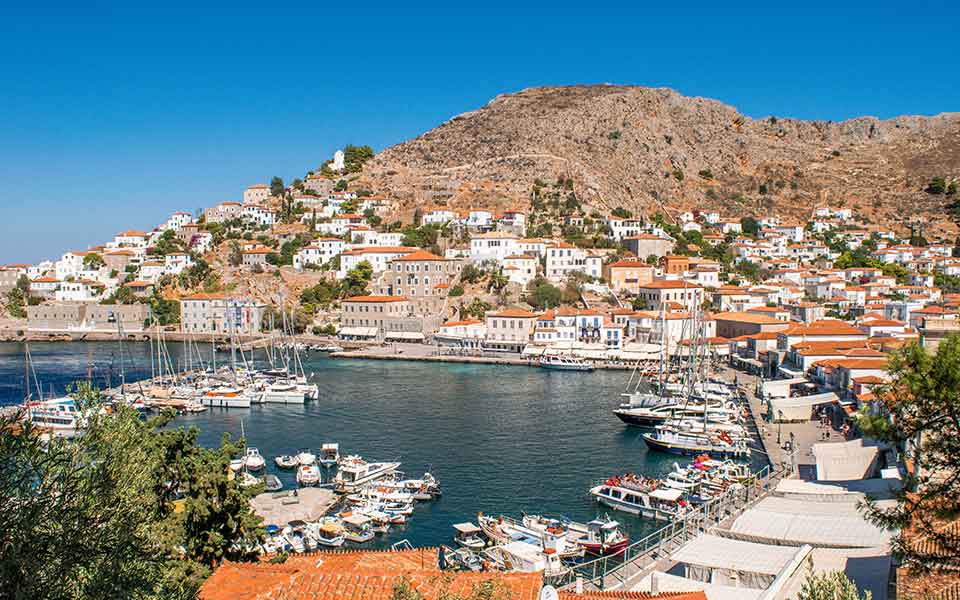Blessed with warm sunshine, sparkling seas, and delicious seasonal cuisine, springtime in Greece will take your breath away. Amid the lush green vegetation, wildflowers and herbs burst into life, covering the landscape in a riot of color and filling the air with their rich, fragrant aromas. There’s nothing more enchanting than Greece in full bloom.
If you’re looking to beat the summer heat and avoid the crowds associated with high season, a spring break on a Greek island may be just the ticket. But with dozens of islands to chose from (277 inhabited islands, according to the Greek National Tourism Organization), where do you start?
Based on our own archive, we’ve come up with a list of seven islands to suit a wide variety of tastes and interests. In it, we offer a few handy tips on what to see and do.
HYDRA
A short ferry ride from Athens, the small Argosaronic island of Hydra has its own unique character. A popular draw for artists, poets, writers, and musicians since the 1960s, including Leonard Cohen, Pink Floyd’s David Gilmour, and his novelist wife, Polly Samson, the island also played a major role in the 1821 Greek Revolution, providing many ships and skilled sailors in the fight against the ruling Ottomans. Walk around the harbor and the surrounding narrow streets (no cars allowed!), and marvel at the imposing mansions that showcase the island’s past economic prosperity. To learn more about the island’s fascinating history, get in touch with Hydra Walking Tours (Tel. (+30) 6976.901.736) for a in-depth guided tour.
In addition to the main town, you should explore the island’s countryside. Hydra boasts a network of footpaths, including one that begins in Plakes Vlyhou and terminates inland at the Church of Aghios Mamas, with stunning views over Mount Eros. The route features smooth inclines and should take about 1.5 hours (2.8km, 330m change of elevation, not signposted). For more information, contact Discover Hydra (Tel. (+30) 6972.084.550).
In the late spring, when the weather is good, you should arrange a boat ride with Hydra by Boat (Tel. (+30) 6987.030.113) and explore some of the nearby islands, inlcuding the tiny islet Dokos, the site of the world’s oldest known shipwreck.
Read more about Hydra here.
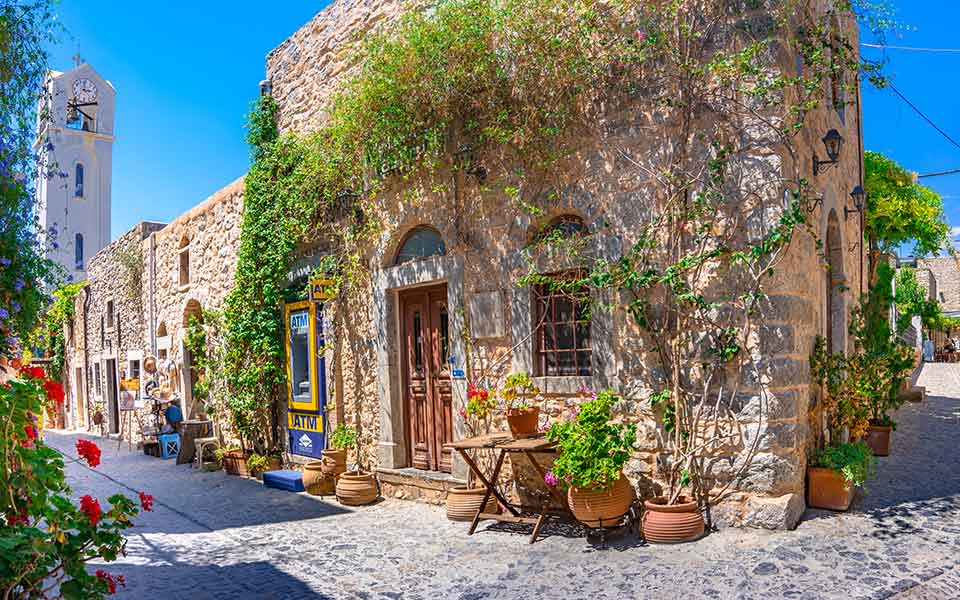
© Shutterstock
CHIOS
Chios is often referred to as the “fragrant isle” due to its extraordinary variety of flora, including all manner of citrus fruits, mastic trees, herbs, hundreds of orchid species, and four species of wild tulips (“lalades”). Spring is the perfect time to visit, as everything is full bloom.
The kidney-shaped island in the northern Aegean is also ideal for hiking, although this activity is still in development. For directions, get in touch with the Association “Friends of Chios’ Trails” (Tel. (+30) 6938.605.170). The best preserved paths are the trail of Kampia Gorge (3km) and the Ancient Ottoman Empire trail, a cobbled path starting from Nea Moni and leading to Lithi (4km).
The area of “Kampos” in the south of the island is idyllic in spring, boasting a 200-hectare expanse of traditional settlements and beautiful mansions, their gardens and orchards filling the air with nose-tingling aromas of orange, tangerine, lemon, bergamot, and bitter orange. At the Citrus Museum (Tel. (+30) 22710.332.02) within the Karalis Estate, you’ll discover the fascinating history of the citrus trade.
The Chios Mastic Museum in Pyrgi (Tel. (+30) 22710.722.12), is well worth a visit, too, as are the beautiful mastic villages, inlcuding Mesta, famous for its labyrinthine narrow streets and medieval castle, Pyrgi, noted for its xista (the geometric and natural black and white motifs on the walls), and the villages of Olympi and Vessa.
Spring offers a great opportunity to swim at the beaches of Mavra Volia, Apothika and Aghia Dynami, without the hordes of summer tourists!
Read more about Chios here.
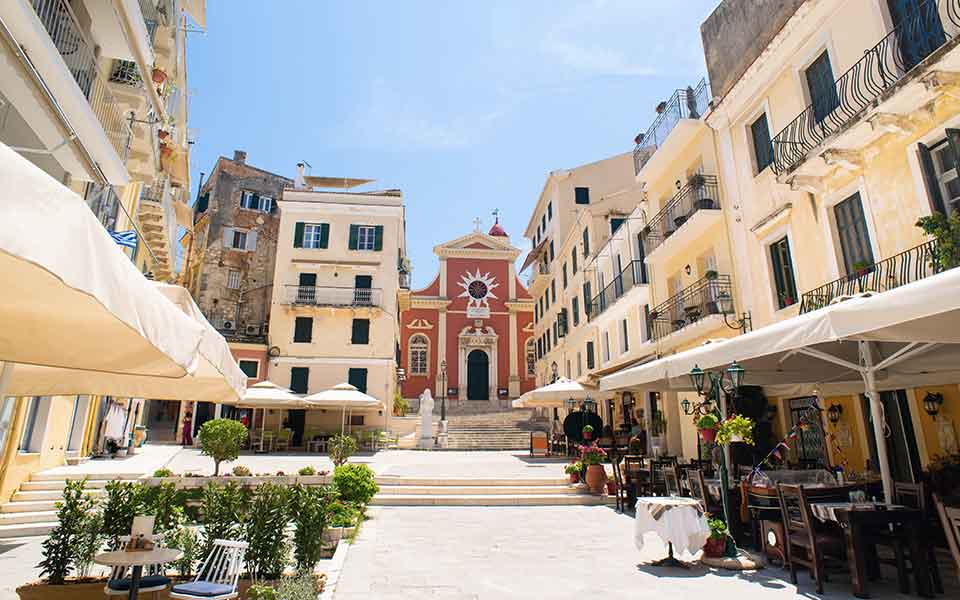
© Shutterstock
CORFU
The Ionian island of Corfu is renowned for its beautiful architecture and idiosyncratic customs. Divided into three regions – the north, the middle, and the south – their natural landscapes, cuisine, and even local traditions are conspicuously distinct to each other, making it a fascinating island to explore, especially in spring.
A good way to get to know Corfu is to embark on a road trip. Start in the north and head to Old Perithia, an atmospheric village on the slopes of Mount Pantokrator. Even though the village has no permanent residents, it remains lively thanks to its famed tavernas. Be sure to visit the Nymfes Waterfalls, near Nymfes village, where you can stop for an impromptu picnic on the wooden benches. Alternatively, you can go west to Porto Timoni and Limni, the famed twin beaches separated by a thin stretch of land.
Leave the northern part of the island behind and head south to the Old Town of Corfu, a paradise for architecture buffs and a UNESCO World Heritage Site since 2007. Take a stroll around the Spianada, the largest square in Greece, and wander through the katounia (narrow streets) and along the wide pedestrianized street of Liston, reminiscent of San Marco Square in Venice. The town is a fascinating blend of western European culture – Venetian, French, and British – with a multitude of hidden architectural gems to pique your interest.
Bring the road trip to a close by venturing to the southern region, which does not have the verdant landscape of the north, nor the architectural marvels in the middle, but is home to several unique settings, including the stunning beaches around Asprokavos in the far south.
Read more about Corfu here.
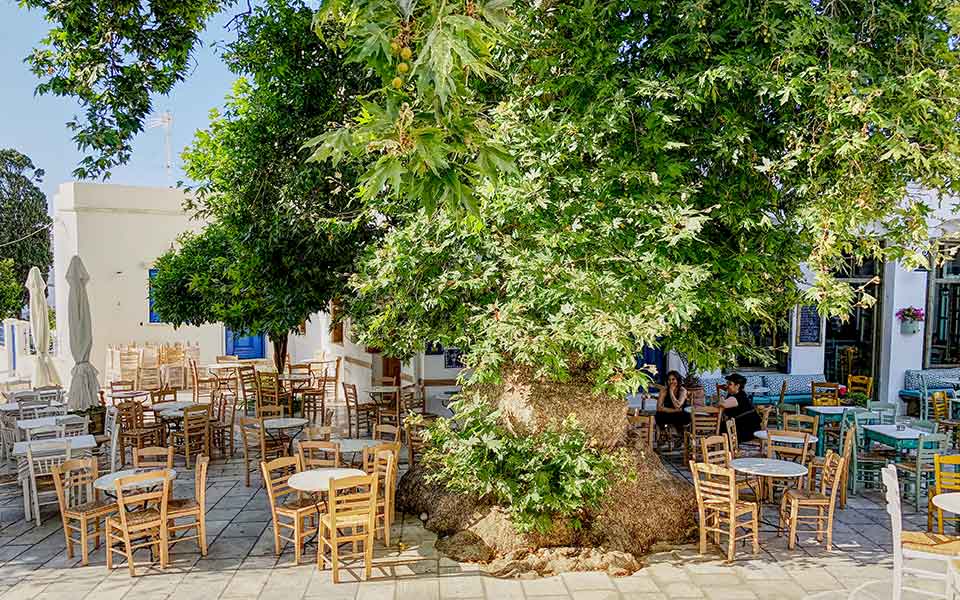
© Shutterstock
TINOS
The Cycladic island of Tinos is a hidden gem. For those in the know, its inland villages are absolutely beautiful in the spring. Triantaro, some 7km from the capital Hora, is famed for its vernacular architecture and boasts spectacular views of the surrounding islands. On a clear day, you can see all the way to Mykonos, Delos, and Syros.
A bit further north, the villages of Kalloni, Steni, Falatados, Ktikados, Krokos, Skalados and Tripotamos are mostly agricultural, growing the island’s famous artichokes and wine grapes on terraced plots interspersed with small, white Cycladic houses. Here you’ll sample rustic island life at its best.
You know you’ve reached the historical village of Volax when you see a bunch of big grey rocks that appear to have fallen from the sky. The round, granite boulders are believed to have come from a volcanic eruption and have become a popular site not just for tourists wanting to take photos, but also for climbers. The village itself that has a reputation for traditional basket-weaving, and it’s still possible to see locals working at the craft.
Tinos has also been evolving into a major destination for foodies in recent years thanks to a local initiative called Tinos Food Paths, aimed at showcasing the island’s agricultural output, traditional products and new restaurants. Don’t miss the opportunity to try as many products and dishes as possible, but also to visit the local workshops and manufacturers.
Read more about Tinos here.
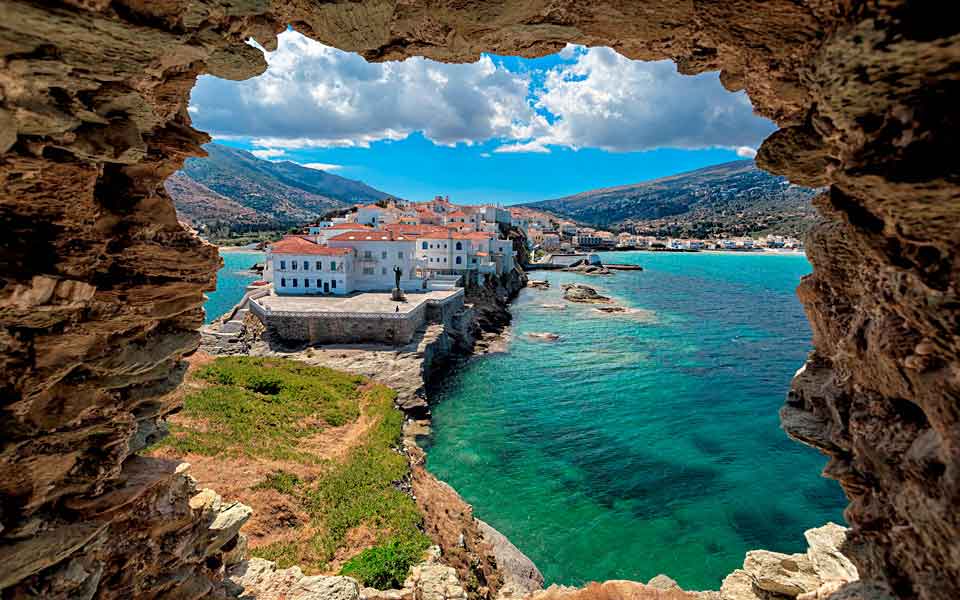
© Shutterstock
ANDROS
Andros’ lush green landscape, especially bountiful in spring and early summer, feels very different to the rest of the Cyclades. Low-key and unpretentious, especially compared to the more touristy islands of Mykonos and Santorini, Andros’ quiet villages, unhurried pace of life, scenic beaches and broad variety of inland walking routes make it an ideal family holiday spot.
The island’s picturesque main town, Hora, located on a narrow peninsula on the east coast, is one of the classiest in all of the Cyclades. Its main road is lined with beautiful cafés and shops selling local products, and the ruins of a Venetian castle can be seen on the nearby islet.
Housed in a lovely mansion, the Maritime Museum of Andros features an extensive collection that portrays the island’s rich naval heritage. Also, drop by the Andros Museum of Contemporary Art, which hosts exceptional exhibitions. Heading down towards the sea, you will find the Nautical Museum on the square of the Unknown Sailor.
Andros is renowned for its walking trails, which meander through beautiful landscapes, crossing mountain slopes, creeks, and little villages. Along the way, expect to encounter babbling natural springs and waterfalls.
A trip to Stenies, a village featuring superbly preserved mansions owned by prominent shipping families, is highly recommended. For a more cosmopolitan feel, head to Batsi.
Pay a visit to the Aghia Marina monastery church in Apikia, which houses a famous icon of the Virgin Mary, said to work miracles.
Read more about Andros here.
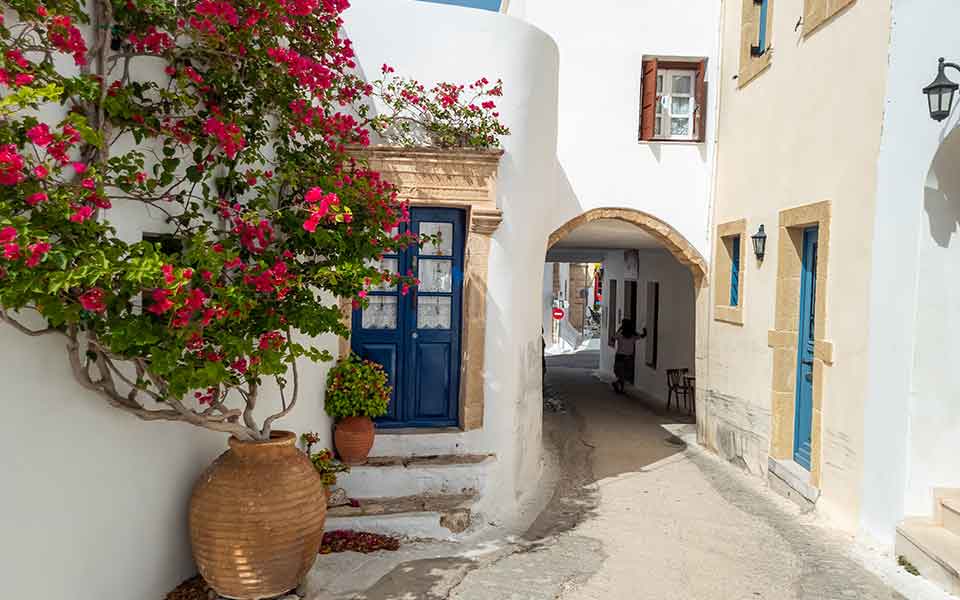
© Shutterstock
KYTHIRA
This southern Greek island has something for everyone. Crowds are easy to avoid, even during the peak of the summer, but, like so many Greek islands, Kythira is even better in the spring.
The island boasts all kinds of beautiful locations, such as the Green Lake, a natural heart-shaped pool that attracts romantic couples, the Fonissa Waterfall in Mylopotamos, the Cave of Aghia Sofia, with its 13th-century wall paintings, and the forest at Gerakari, a great place for a picnic.
Kythira is beloved by adventure seekers, too, thanks to its ferrata-style hiking trail running below Paliochora and combining trekking, canyoning, and climbing.
Kythira resembles the neighboring Peloponnese in having plenty of medieval castles and fortifications. These include Paliochora (the onetime capital of the island), Mylopotamos (a Venetian castle full of charming ruins), the 16th century “Kastelo” of Avlemona and, of course, the Castle of Kythira (aka “Fortetsa”) in Hora, a 13th century Venetian fort that was rebuilt in the 16th century and is one of the island’s best sights. The information center at the Fortetsa includes a fascinating exhibition on the coats of arms of the island’s various noble families in the Middle Ages.
Read more about Kythira here.
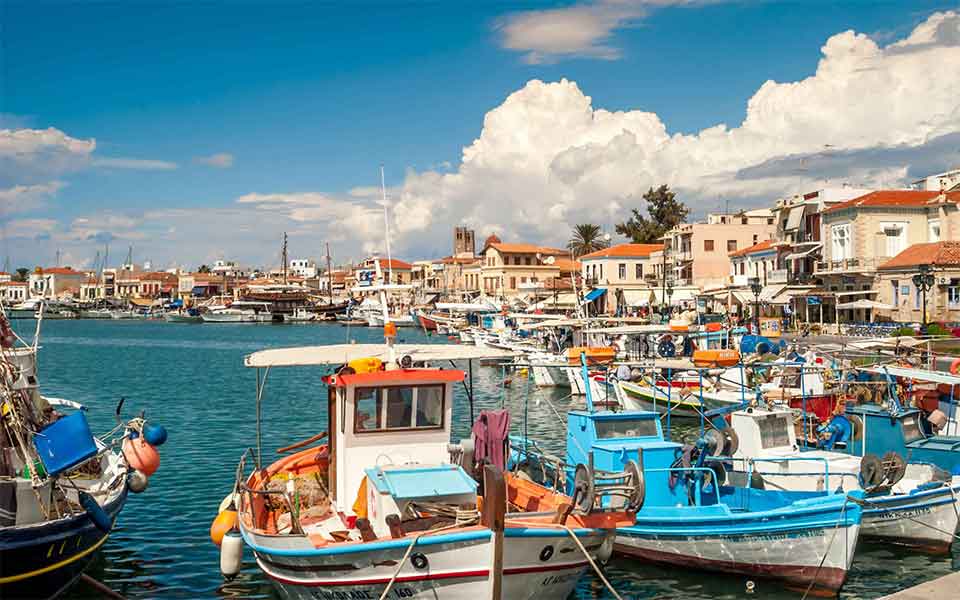
© Shutterstock
AEGINA
Only an hour by ferry from Piraeus, the small island of Aegina is blessed with natural beauty and plenty of things to see and do, and eat!
A popular weekend retreat for Athenians, Aegina operated as the first capital of the newly formed Greek state after the country won independence from Ottoman rule in 1821. For archaeology buffs, the island is home to the exceptionally well-preserved Temple of Aphaia (5th century BC), overlooking the sea towards the mainland on a hill above Aghia Marina. When the atmosphere is clear, the Acropolis in Athens and the temple of Poseidon in Sounio are both visible from the hilltop (the three temples are famous for making a geographical isosceles triangle).
Watch the sun go down through the trees of the ancient olive grove on the slopes of Mount Oros – the island’s highest peak – where the view is incredible. The grove is located in a valley and features ancient olive trees whose trunks are living sculptures shaped by nature.
For most of the island’s known history, its main settlement was located at Palaiochora, also known as the the “Mystras of Aegina.” Located in a valley at the center of the island, to avoid the raids of pirates, the town’s houses were built amphitheatrically on a hill, crowned with a fort. Today, the remains of this old capital consists of 38 churches spread around the hill.
The main town of Aegina boasts some fabulous fish tavernas, and don’t forget to try the island’s famous pistachio nuts!
Read more about Aegina here.

